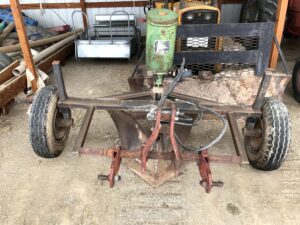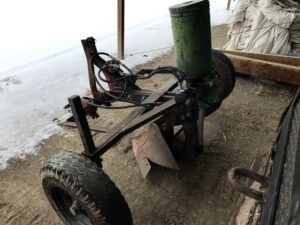Description
Contour trenchers are used in the restoration of degraded rangeland to conserve rainfall. The contour trencher uses a single-shank ripper (subsoiler) to fracture the soil to a depth of 12 to 18 inches. Forty to 75 horsepower tractors are required to pull the ripper. Wings or a furrow opener can be attached to the ripper’s shank to form a furrow. A single-row seeder is mounted on the frame of the ripper and powered by a hydraulic motor. The seed tube is attached so it can be positioned to place seed on the upslope side of the furrow or within the furrow. Shops construct these units from off-the-shelf components. A multi-shank unit is under development for the Umatilla National Forest in cooperation with the Forest Service’s Missoula Technology and Development Center for road and trail decommissioning. This 6-foot wide unit will rip to a depth of 24 inches and will require a crawler tractor with a minimum of 150 horsepower and a ripper toolbar for operation. Contour disk bedders use two rows of cropland disk bedders to form soil dikes along the contour to trap rainfall. A single-row seeder can be mounted on the bedder’s frame in the same manner as the ripper’s installation.
Application
Contour trenchers break-up hard pans, trap rainfall, improve infiltration, and promote the rejuvenation of resident grasses and the germination, emergence, and establishment of seeded grasses. Trenches and dikes are installed on the contour, and distances between these soil disturbances vary with the slope, amount of grass cover, and expected rainfall. Seed is placed above the ridge of soil on the upslope side of the trench/furrow or in the furrow. When ripping is not feasible due to rocky soil or other factors, disk bedders can be used to form ridges (borders, beds, dikes) to trap rainfall and promote growth of seeded grasses. Disk bedders can traverse limited amounts of rocks and brush debris. It is recommended that the contours be flagged using a level before installation. It is further recommended that skips be left on about 100 – 150 foot spacing when diking so that intense rainfall will not breach the dikes.



